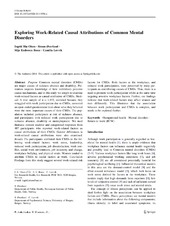| dc.description.abstract | Purpose Common mental disorders (CMDs) are major causes of sickness absence and disability. Prevention requires knowledge of how individuals perceive causal mechanisms, and in this study we sought to examine work-related factors as causal attribution of CMDs. Methods A trial sample of n = 1,193, recruited because they struggled with work participation due to CMDs, answered an open-ended questionnaire item about what they believed were the most important causes of their CMDs. The population included participants at risk of sickness absence, and participants with reduced work participation due to sickness absence, disability or unemployment. We used thematic content analysis and categorized responses from 487 participants who reported work-related factors as causal attributions of their CMDs. Gender differences in work-related causal attributions were also examined. Results The participants attributed their CMDs to the following work-related factors; work stress, leadership, reduced work participation, job dissatisfaction, work conflict, social work environment, job insecurity and change, workplace bullying, and physical strain. Women tended to attribute CMDs to social factors at work. Conclusion Findings from this study suggest several work-related risk factors for CMDs. Both factors at the workplace, and reduced work participation, were perceived by study participants as contributing causes of CMDs. Thus, there is a need to promote work participation whilst at the same time targeting aversive workplace factors. Further, our findings indicate that work-related factors may affect women and men differently. This illustrates that the association between work participation and CMDs is complex, and needs to be explored further. | en_US |

